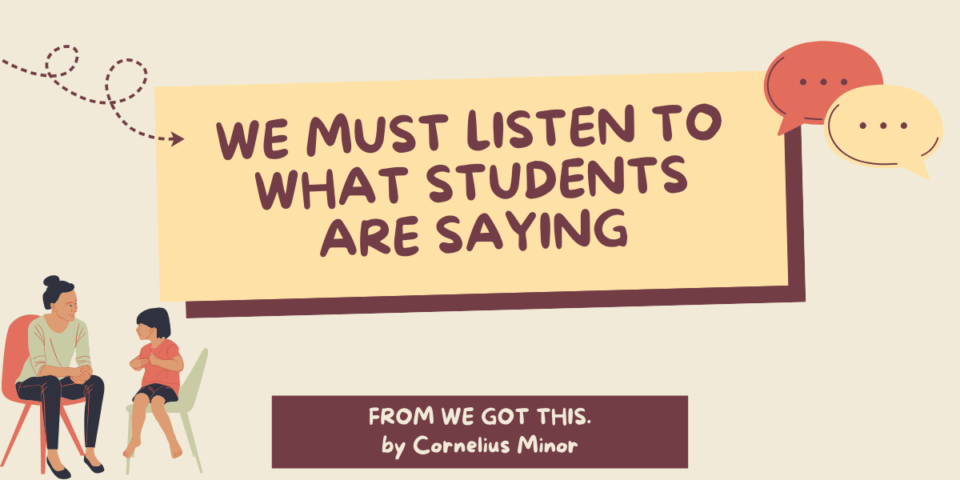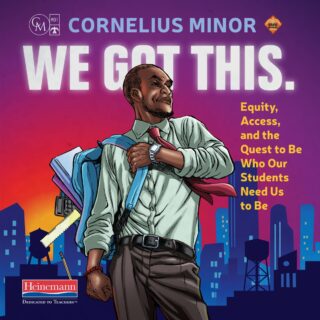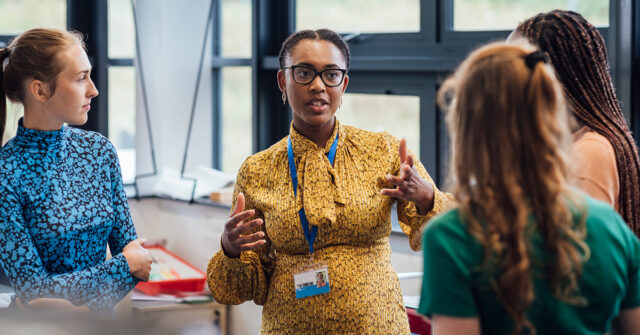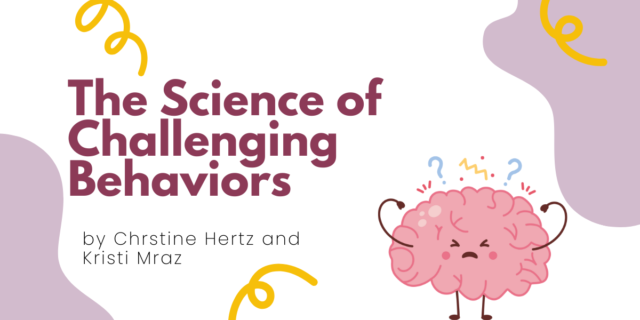
The following is adapted from We Got This. by Cornelius Minor.
When we seek to craft better realities for our students and our peers, our listening has to be informed by what we know, by what we are learning, and by our desire to actually hear what our students, communities, and partners are telling us. This kind of listening has three parts.
- There is the act of listening itself, more specifically, the hearing. This is the stuff that happens at the actual site of the message being delivered. Sometimes that message is communicated with words that are either spoken or written. Those messages are decently easy for educators like us to receive, but sometimes messages are communicated through behaviors or through silences, and sometimes the messages do not happen in one instance; instead they are communicated across several instances over time. However the message comes to us, the role of the educator during the first part of any communicative act is to simply hear. Not to judge, not to solve, not to prescribe, but first to hear. Sometimes it helps here to ask gently clarifying questions to confirm what you’ve heard or to paraphrase in order to communicate that your partner has been heard. Most of our students don’t want complex solutions or programmatic approaches. To many kids, “my teacher hears me” is solution enough.
- After we hear, we’ve got a bit of thinking to do. After receiving any message, we’ve got to name what we think we heard and plan a response. In teaching, responses are not just what we say; they are what we do and the habits and rituals we establish. These things, more than anything else, communicate that we value what the people in our school communities bring to the table. As we engage in this work, it is important to recognize that understanding what others communicate and making sense of those ideas are both value-based actions. Because we spend a lot of time communicating with people who approach school with different values, full understanding might not come readily to us, and that is OK, as long as our work is characterized by active study, so that our understanding deepens with time.
- Most of the book focuses on the question that guides the third part of authentic listening as I present it here. After hearing and thinking, we must ask ourselves, “Because of what I’ve heard, how can I make active and longstanding adjustments to my classroom community, to my actual teaching, and to how the department, grade, or school operates?”
Here, we recognize that teaching is not monologue. It is dialogue. And after hearing what kids have to say, I’ve got to do something.
Participating in that dialogue requires us to kill the assumption that children and their understanding of the world are flawed without us. We know that quite the opposite is true. We are in this profession because we believe that they have the answers.
Many of us come to this knowing that we teach kids so that they can deal with the challenges they will encounter in their lives, not so they can navigate the challenges that we faced in ours. To really move kids, there has to be some act of continual understanding. There has to be evidence that the teacher is learning from students too.
Understanding why children choose to learn is one of the first things that I can learn from students. Fortunately for us, children choose to learn for the same intrinsic reasons that adults can choose to learn. I choose to learn something because it:
- can help me to solve a problem that feels very real to me
- gives me greater freedom in my life as I live it right now
- creates an opportunity for me to do something that I want to do soon
- feels like a worthy challenge—to me
- helps me to do something good for people that I care about
- connects me to people that I want to know
- is fun or cool (as I define it)
- allows me to survive something or someone that threatens my well-being.
So what do these reasons for learning mean for my teaching every day? Anytime we introduce a lesson or activity, it’s important to be clear about why this experience is happening in our classroom.
Read onto How to Ensure Your Lessons Speak to Students.



